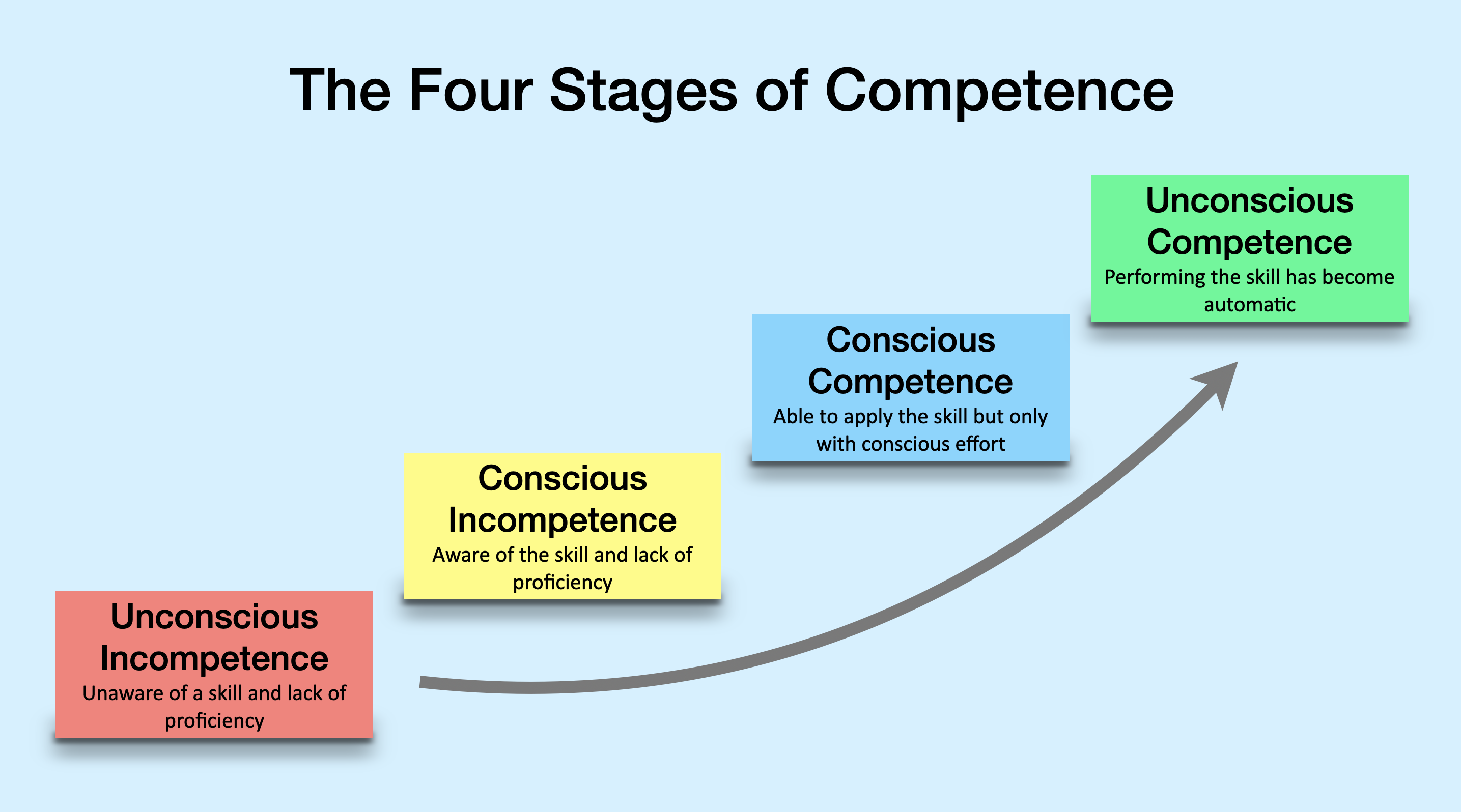There is a conceptual model of skill development that has been around for many years. Noel Burch generally is credited with having developed the model. Most of you will know it as the four stages of competence. It goes like this.
Stage One – Unconscious Incompetence
At this stage, an individual doesn’t understand or know how to do something but isn’t aware of the skill deficiency. Where a particular skill is concerned, the individual is Ignorant.
Stage Two – Conscious Incompetence
At this stage, the individual doesn’t understand or know how to do something but is conscious of the skill deficiency. The individual is Aware.
Stage Three – Conscious Competence
At this stage, the individual understands and knows at an elementary level of skill how to do something, but developing the new skill requires a great investment of concentration and effort. The individual is Learning.
Stage Four – Unconscious Competence
At this stage, the individual has repeated the skill so many times and has become so proficient that performing the skill has become “second nature.” It is performed automatically and requires no particular concentration. At this level, the individual exhibits Mastery.
Everyone reading this post has experienced the four stages of competence relative to something. For some, it may have been when you learned to play a musical instrument. For many, it may have been when you were learning to drive – especially if you learned to drive a stick shift car. Learning a new sport is a common way for people to experience the four stages (hitting a backhand well doesn’t come easily). I personally remember the conscious incompetence of learning to type and the disbelief that I would ever learn to do it without staring at each individual keystroke. Each of us has some reference point for the learning journey that ends in a skill becoming automatic if you choose to progress that far. And we know the satisfaction of reaching that outcome.
As the title of this post implies, I have been thinking about the four stages of competence model in relation to the development of skill in change management as it applies to organizations. I realize that I’m making a leap in the unit of analysis from the individual to the organization. However, the model has utility for thinking about an organization’s developmental journey in the matter of change management capability. It also leads to the interesting question that is the title of this post.
Looking at organizations through the lens of the model, what might we see?
There are a lot of Stage One organizations. We can all name one or more. Their leadership and memberships exist in a state of ignorance relative to managing change. They’re not immune to change, so they must confront it when it occurs. I won’t speculate about what the process might look like or what may result, but organizations that have no change management capability do change.
There are also many Stage Two and Three organizations. If fact, in my experience, the great majority of organizations likely fall into these two developmental stages.
Stage Two organizations have come to recognize that the way they have been making change has been arbitrary and suboptimal. They have become aware of their incompetence and recognize that there is a discipline that they can bring to bear on organizational change to improve both the experience and the outcome. Being conscious of their skill deficiency motivates some to become Stage Three organizations.
Stage Three organizations have moved to action. They have invested in developing a capability for managing change. They have put time and effort into developing internal resources and apply the methods and means they have learned to improve the way they make and manage change. Further, they strive to do it consistently across the organization wherever changes may be occurring. Many of you have worked with Stage Three organizations or are working with them currently. They are in a state of conscious competence and their learning inches them toward Stage Four.
What about Stage Four organizations? Stage Four organizations are like an encounter with a rare animal. They exist, but the chances of meeting one are few. In an earlier post (Meaningful Engagement Vs. Buy-In: What’s The Difference and Why Should I Care?), I discussed why buy-in as the objective of change management versus commitment through engagement wins out when we want and need so much more.
“It seems defensible to conclude that buy-in typically triumphs as the objective of change management because it doesn’t require the same level of leader or manager commitment that meaningful engagement does. Aiming for buy-in just doesn’t demand as much time and effort. In the end, unfortunately, expedience wins.”
The same condition is present at Stage Four. Most organizations are not willing to commit the time, resources, and energy or establish the cultural context to evolve to this level of change competency.
But the intrigue of the question posed in the title remains. What if more organizations committed their time, resources, and energy and developed their change capability to the level of unconscious competence? What if they all did? What would that be like and what would be unleashed? How might that happen and how might the outcomes they achieve be different than what we have come to expect?
These questions and others are the subject of this series of posts. In the second post, I will describe what change capability at the level of unconscious competence can look like. In the third post, I will explore what it takes to get there. In the final post, I will present examples of Stage Four change management ability and tie all of the elements together.
If you’d like to learn more about how you can evolve change management for your organization, please visit thechangekit.com.

